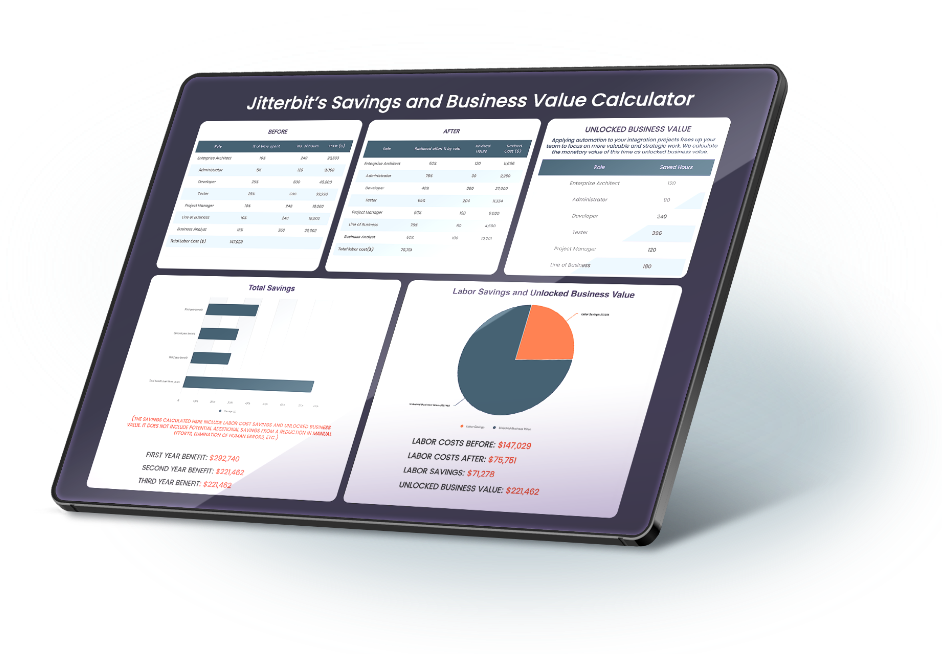Staying ahead in today’s business landscape requires a cutting-edge, agile, and scalable tech stack. And what sits at the heart of such a tech stack? Integration platform as a service, or iPaaS.
What Is iPaaS?
iPaaS (Integration Platform as a Service) is a cloud-based integration solution that integrates data sources, applications, and systems to simplify and accelerate integration and automation. With iPaaS, you can eliminate manual business processes and increase productivity across your organization.
iPaaS solutions help you easily build, deploy, and manage integrations across cloud services and on-premise systems, helping you establish data flows both within your organization and with third parties or partners.
How Does iPaaS Work?
iPaaS, or Integration Platform as a Service, works by connecting various systems, applications, and data sources to enable seamless communication and automation across an organization’s tech stack. By leveraging pre-built connectors, APIs, and low-code tools, modern iPaaS platforms facilitate the design, deployment, and management of integrations, eliminating the need for extensive coding or complex IT involvement. Whether it’s connecting cloud-based applications, managing iPaaS integrations between on-premise and cloud systems, supporting real-time data flows, or enabling advanced data strategies like data mesh architecture, iPaaS addresses a wide range of use cases.
Benefits of iPaaS for Modern Enterprises
In a world where data connectivity and workflow automation are essential for operational efficiency, the benefits of iPaaS include streamlining and optimizing processes, fostering collaboration across teams and systems, and creating a single source of truth for your data.
With iPaaS (Integration Platform as a Service) at the core of your digital landscape, business users and IT professionals alike can leverage these advantages to drive organizational automation, freeing up time to focus on what truly matters: your customers, your goals, and your growth.
Common iPaaS Challenges in 2025
As organizations increasingly adopt iPaaS platforms to streamline integrations and automate workflows, they encounter challenges that can hinder efficiency and growth. Below are some of the most common iPaaS challenges businesses face today:
-
Application Sprawl
The last few years have seen unprecedented growth in enterprise SaaS applications. However, these independent applications, leveraged across different functions of an organization, are not designed to communicate with each other easily, leading to data silos. This fragmentation highlights one of the key iPaaS challenges, as organizations often struggle to implement seamless integrations across their systems. Adding to this complexity is the mix of legacy, on-premises, and cloud systems that often exist across an enterprise. This data is stored in disparate systems and lacks consistency, presenting significant hurdles for iPaaS platforms in addressing data mapping and migration issues, which prevent businesses from gathering actionable insights effectively.
-
Dwindling IT Resources
IT departments are often struggling to keep up with long to-do lists and the blistering pace of change. As IT talent and resources become increasingly scarce, the demand for iPaaS platforms to simplify business application and data integration projects continues to grow. While iPaaS solutions empower business users outside of IT to participate in automation initiatives and develop integrations, these efforts can sometimes bypass IT’s governance protocols. When integrations are created outside of the security and compliance frameworks set by IT, organizations face significant risks, including data breaches and operational inconsistencies.
-
Tech Complexities
Merging different IT infrastructures, software solutions, and data systems can be complex. Keeping up with evolving technologies and leveraging iPaaS capabilities to integrate new systems seamlessly can be a significant challenge for many organizations.
-
Data Security and Compliance
Consolidating and migrating data from different sources can be time-consuming and prone to errors, even when utilizing iPaaS platforms. While iPaaS solutions streamline data integration and migration, organizations must still address challenges related to data security and compliance. Ensuring that iPaaS implementations adhere to regulations is crucial, especially with growing concerns about data privacy and the need to protect sensitive information.
-
Cost Management
Managing the expenses associated with maintaining multiple systems and applications can become overwhelming. The lack of integration between legacy, on-premises, and cloud solutions often leads to redundant processes and inefficiencies, driving up costs. Leveraging iPaaS platforms allows organizations to consolidate and streamline their systems, reducing operational expenses and eliminating unnecessary redundancies. By optimizing iPaaS integrations, businesses can achieve better cost control while enhancing overall productivity.
Choosing the Right iPaaS Platform: Key Factors
iPaaS helps companies navigate the complexities of integration processes, futureproof their operations, and increase the value of their IT investments through a robust integration platform.
When selecting an iPaaS platform provider and solution, here are key factors to consider:
-
Ease of Use
iPaaS allows a low-code or no-code approach, increasing the speed at which integrations are developed and deployed. This reduces the dependency on specialized resources or heavy IT involvement and also empowers non-technical business users (often called ‘citizen integrators’) to develop their own integration platform. An iPaaS platform provides pre-built connectors, adapters, templates, and recipes that also accelerate data integration flows.
-
Time to Value
With pre-built connectors and a low-code approach, companies are able to quickly automate key business processes, such as quote to cash or employee onboarding, to realize fast ROI. Organizations can simply subscribe and start integrating their apps to rapidly accelerate digital transformation.
-
Cost Efficiency
As your tech stack grows, integration platform costs are bound to increase. iPaaS eliminates the need to build an integration platform from the ground up, as the infrastructure and resources needed to manage these integrations are all provided by the iPaaS vendor, resulting in substantial savings. iPaaS platforms are typically procured as a subscription service, providing customers with predictable and manageable expenses.
-
Scalability and Flexibility
iPaaS platforms enhance business agility, making it easier to adapt and accommodate dynamic changes inside or outside your organization. New solutions and applications can be quickly integrated with existing systems, taking away the overhead of labor, costs, hardware, and time.
-
Built-in API Management
Complete iPaaS solutions also include API Management. Organizations can leverage these capabilities to create, publish, manage, and measure APIs across the entire API lifecycle. This helps organizations operate in real time and create microservices from a single, secure platform.
-
Centralized Data Management
iPaaS allows you to develop, design, and manage integrations from a single, centralized, web-based console, making it easy to monitor all your integration flows and processes from a centralized view across the enterprise.
-
Efficiency and Productivity
iPaaS automates tedious business processes, saving valuable time, costs, and resources and yielding significant efficiency gains. With an intuitive interface and user-friendly design, both business users and IT pros can expedite data integration flows, eliminate manual processes, and free up time for more strategic initiatives.
-
Security and Governance
iPaaS helps strengthen IT security, improve compliance, and increase transparency by maintaining a seamless flow of information between teams. It sets standards and best practices for users to follow for self-service tasks. With iPaaS, you can also control and monitor your integrations and processes anywhere, anytime, and get full visibility across the enterprise with a centralized enterprise integration dashboard.
-
Implementation Support
Select a capable technology and iPaaS vendor who will help you through your use case implementation and rollout to maximize your ROI. Selecting a vendor that provides professional implementation support and managed integration services is crucial to guarantee a seamless transition and successful adoption into your organization.
Jitterbit’s iPaaS solution, Harmony, supports all of the above (and then some), but here are a few reasons Jitterbit stands out from the crowd:
- Exceptional Customer Support: With a 9/10 G2 rating for Quality of Support and a Silver Stevie Award® for 2023 Customer Department of the Year, our support sets us apart.
- Ease of Use: Our all-in-one platform simplifies complex integration platform processes & data mapping, earning 4.6/5 stars on G2 for ease of use.
- Rapid Time to Value: Our iPaaS solutions can accelerate time to value up to 80% faster than custom-coded integrations.
What Are Common iPaaS Use Cases?
The possibilities are endless. These iPaaS use cases highlight the platform’s versatility in addressing integration challenges across various domains, offering a unified and efficient approach to managing your digital ecosystems.
-
Cloud Application Integration
iPaaS can connect different cloud-based applications to ensure seamless data flow between them. This is particularly useful when organizations use multiple SaaS solutions that need to work together.
-
Hybrid Cloud Integration
With iPaaS, you can easily integrate on-prem systems with cloud-based applications. This is crucial for businesses that have a mix of legacy systems and modern cloud services and solutions.
-
Data Integration
iPaaS can be used to integrate and synchronize data from various sources, such as databases, data warehouses, and data lakes. This helps maintain a unified and up-to-date dataset for business analytics and reporting.
-
API Management
Modern iPaaS platforms include API management capabilities, allowing businesses to create, publish, and manage their APIs and integration landscape. This is valuable for exposing services and data to internal or external developers.
-
B2B/EDI Integration
iPaaS facilitates integrations between different organizations. This is especially important for supply chain management, where companies need to exchange data with trading partners and suppliers.
-
Internet of Things (IoT) Integration
iPaaS can connect and integrate data from IoT devices, enabling organizations to collect, process, and analyze data generated by sensors and devices in real time.
-
Ecommerce Integration
For ecommerce businesses, iPaaS helps integrate online stores with backend systems, such as inventory management, order processing, and customer relationship management (CRM) systems.
-
Event-Driven Integration
iPaaS supports event-driven architectures, allowing organizations to respond in real time to system events or triggers. This is beneficial for scenarios where immediate actions are required based on specific conditions.
-
Mobile Application and Data Integration
iPaaS can connect mobile applications with backend systems, ensuring that data is synchronized and processed seamlessly between mobile devices and enterprise systems.
Best Practices for Implementing iPaaS Integrations
When implementing iPaaS, it’s important to follow best practices to successfully launch your integrations and maintain data accuracy. Here are some guidelines to follow when implementing iPaaS integration solutions:
-
Define Clear Objectives
Clearly define the objectives of your integration project. Understand what you aim to achieve, whether it’s improving business processes, enhancing data visibility, or enabling new functionalities.
-
Assess Integration Platform Requirements
Conduct a thorough assessment of your integration platform requirements, taking into account the systems, applications, and data sources that need to be connected. Identify any specific protocols, formats, or standards involved.
-
Choose the Right iPaaS Solutions
Select iPaaS integration solutions that align with your organization’s needs. Consider factors such as ease of use, scalability, security, and the ability to support the specific integration patterns required for your project.
-
Data Quality and Governance
Prioritize data quality by implementing data governance practices. Ensure that data is accurate, consistent, and compliant with relevant regulations. Define data ownership and access policies to maintain control over sensitive information.
-
Security and Compliance
Implement robust security measures to protect data during transit and at rest. Ensure that the iPaaS solutions comply with industry-specific regulations and standards. Encrypt sensitive information and use secure authentication methods.
-
Monitoring and Analytics
Implement comprehensive monitoring and analytics tools to track the performance of your integrations. Monitor data flows, error rates, and system health to identify and address issues promptly.
Not convinced about the benefits of iPaaS? Try our Savings Calculator
Custom-coded integrations can be deceptive in their apparent cost-effectiveness. While they may seem tailored to your specific needs, the long-term implications can be substantial. The investment of time, money, and skilled resources in developing and maintaining custom integrations often outweighs the initial perceived benefits. Moreover, the rigidity of such integrations can hinder the scalability and adaptability in a dynamic business environment.
With iPaaS solutions, your business can break free from the constraints of custom-coded integrations and embrace a more agile, cost-effective approach.
Curious about how much your business could save by switching to an automated integration approach? Are you looking to make a business case for investing in an iPaaS solution?
Jitterbit’s Savings and Business Value Calculator simplifies this process. By answering a few straightforward questions, the calculator generates an estimate of your potential labor and resource savings by using an iPaaS. It is a powerful tool that can help you estimate these savings and showcase the true potential of integrating an iPaaS into your operations.
Jitterbit’s iPaaS automation platform offers a direct pathway to increased efficiency, substantial savings, and enhanced scalability. Take the first step towards a more streamlined future – explore the possibilities with Jitterbit today.




